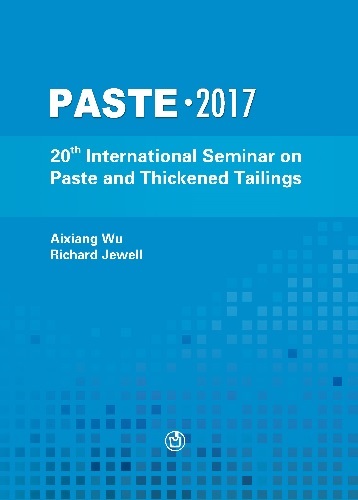The effects of mixing time on cement paste slurry transport and mechanical property

|
Authors: Yang, L; Wang, H; Wu, S; Wu, A; Wang, Y; Zhou, X; Zhang, L; Yang, X |
DOI https://doi.org/10.36487/ACG_rep/1752_16_Yang
Cite As:
Yang, L, Wang, H, Wu, S, Wu, A, Wang, Y, Zhou, X, Zhang, L & Yang, X 2017, 'The effects of mixing time on cement paste slurry transport and mechanical property', in A Wu & R Jewell (eds), Paste 2017: Proceedings of the 20th International Seminar on Paste and Thickened Tailings, University of Science and Technology Beijing, Beijing, pp. 141-148, https://doi.org/10.36487/ACG_rep/1752_16_Yang
Abstract:
The optimization of mixing time could benefit transport and mechanical performances of paste due to the enhancement of cement dispersion and paste fluidity induced by mixing process. However, research on the effects of mixing time during paste preparation has rarely focused on the reasons and mechanisms for the changes in characteristic properties. In this paper, a mining paste mixing system was simulated based on the similarity principle that recorded the slump and mechanism of paste among several mixing modes and on the clarify principles with which mixing process affected paste’s properties. The results indicated that in consideration of equal linear velocity, the transport and mechanical properties of paste were definitely improved with time when mixing time was less than 3 min. Once mixing time exceeded 3 min, the properties of paste were improved at a slower rate until they became insensitive to mixing action at four minutes. Taking into account the paste properties, operation efficiency and energy consumption, the optimal mixing time was determined as approximately 3 min. The reform towards mixing system which met paste filling flow of 90 m3/h was implemented by extending mixing time to 3.33 min. Consequently, the slump was definitely enhanced by ≤ 10%. Besides, the uniaxial compression strength (UCS) of specimens curing for 28 d was enhanced from 0.69 to 1.37 MPa.
References:
Beitzel, H., Charonnat, Y. and Beitzel, M. 2003, ‘Assessment and classification of performance mixers’, Materials and Structures, vol. 36, no. 258, pp. 250-264.
Brand, A.S., Roesler, J.R. and Salas, A. 2015, ‘Initial moisture and mixing effects on higher quality recycled coarse aggregate concrete’, Construction and Building Materials, vol. 79, pp. 83-89.
Cazacliu, B. 2008, ‘In-mixer measurements for describing mixture evolution during concrete mixing’, Chemical Engineering Research and Design, vol. 86, no. 12, pp. 1423-1433.
Cazacliu, B. and Roquet, N. 2009, ‘Concrete mixing kinetics by means of power measurement’, Cement and Concrete Research, vol. 39, no. 3, pp. 182-194.
Chopin, D., Cazacliu, B., Larrard, F.D. and Schell, R. 2007, ‘Monitoring of concrete homogenization with the power consumption curve’, Materials and Structures, vol. 40, no. 9, pp. 897-907.
Doucet, J., Bertrand, F. and Chaouki, J. 2008, ‘A measure of mixing from Lagrangian tracking and its application to granular and fluid flow systems’, Chemical Engineering Research and Design, vol. 86, no. 12, pp. 1313-1321.
Ferraris, C.F. 2001. ‘Concrete mixing methods and concrete mixers: State of the art’, Journal of Research of the National Institute of Standards and Technology, vol. 106, no. 2, pp. 391-399.
Lindenberg, C., Schöll, J., Vicum, L., Mazzotti, M. and Brozio, J. 2008. ‘Experimental characterization and multi-scale modeling of mixing in static mixers’, Chemical Engineering Science, vol. 63, no. 16, pp. 4135-4149.
Lombois-Burger, H., Colombet, P., Halary, J.L. and Damme, V.H. 2006, ‘Kneading and extrusion of dense polymer-cement pastes’, Cement and Concrete Research, vol. 36, pp. 2086-2097.
Wendling, A., Mar, D., Wischmeier, N., Anderson, D. and McIff, T. 2016, ‘Combination of modified mixing technique and low frequency ultrasound to control the elution profile of vancomycin-loaded acrylic bone cement’, Bone and Joint Research, vol. 5, pp. 26-32.
© Copyright 2025, Australian Centre for Geomechanics (ACG), The University of Western Australia. All rights reserved.
View copyright/legal information
Please direct any queries or error reports to repository-acg@uwa.edu.au
View copyright/legal information
Please direct any queries or error reports to repository-acg@uwa.edu.au